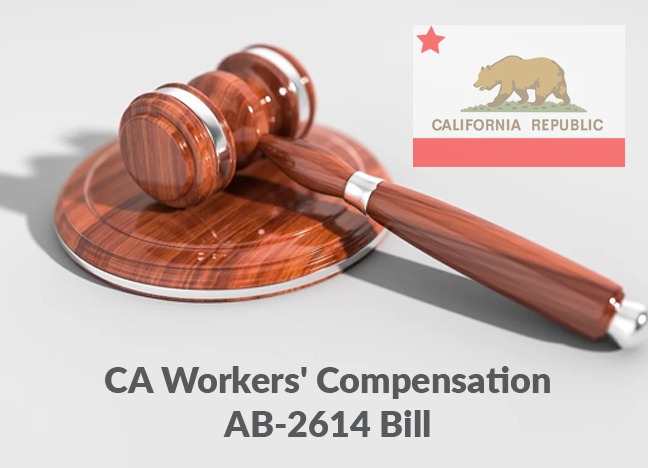Amongst 5 other bills passed last Thursday May 19’th, the California House Appropriations Committee voted to pass AB 2614.
According to today’s report in workcompcentral.com, a paid subscription service:
“The Assembly also voted 60-0 to pass AB 2614, by Assemblyman Freddie Rodriguez, D-Chino, which would order the Commission on Health and Safety and Workers’ Compensation to undertake a study of potential premium-shifting tactics through staffing firms.
The bill would direct the Commission on Health and Safety and Workers’ Compensation to complete by Jan. 1, 2024, a report assessing whether employers with poor work comp risks are reclassifying workers as temporary staff or labor contractor employees to dodge work comp costs.”
This bill specifically requests a study into the use of staffing agencies to inappropriately reduce work comp premiums by using the workers’ compensation experience modification factor of the staffing group, versus the job-site employer in control of safety in the workplace. The group is targeting a loophole in the PEO regulation Rule #4 that specifically excludes staffing agencies from using the client experience of an employer to develop an experience modification, therefore allowing it to charge premiums not commensurate with the underlying exposure being contemplated. To quote passages of the bill that was edited down heavily from initial:
“This bill would require the commission to report to the Legislature, on or before January 1, 2024, any widespread issues or instances of client employers or labor contractors, as defined, being used to shift workers’compensation responsibility away from those employers who control jobsite risk to employees, among other things.
“Report to the Legislature containing both of the following: line 5 (1) Any information on widespread issues with or instances of line 6 client employers, as defined in paragraph (1) of subdivision (a) line 7 of Section 2810, and labor contractors, as defined in paragraph line 8 (3) of subdivision (a) of Section 2810, being used to shift workers’ line 9 compensation responsibility away from those employers who line 10 control jobsite risk to employees. line 11 (2) Whether employers with poor workers’ compensation risk line 12 are reclassifiying their employees as temporary staff or employees line 13 of labor contractors in order to shift the employee onto the line 14 workers’ compensation coverage of the labor contractor.”
Besides being the lead indicator of a given business’ financial safety record against its peers, experience modification factors also create the base premium for California to assess 7 different surcharges (WCFA, WCA, UEBT, SIBT, OSHF, LEC and CA), all near and dear to the heart of the State. Additionally, Cal-OSHA has a special “High-Hazard Unit” that targets experience modifications in excess of 125% for inspection and potential fines. This business model neutralizes their ability to address those worksites that would fall within that criteria. They completely fall off their radar in total and so abilities to address safety concerns through inspection/fine are lost as well.
Outside of those “in the know”, there is a foundational confusion of “what is a PEO” versus “what is a staffing company” nationally, with California being no exception. Add “gig” economy workers, employers of record and payrolling platforms and more confusion arises. I know the National Association of Professional Employer Organizations (“NAPEO”) is fully engaged addressing licensure and the Model Act to conform with their efforts Countrywide. The lack of formality regarding PEO is now rather unique in California, with 36 States having some type of formal licensing or registration requirement today.
In the eyes of California statute, staffing, employment, talent or other types of “agency” that involve the transfer of labor from one employer to another. While all of these other types of labor contractors transfer labor, a PEO does not, instead entering into legal agreements with fellow employers that provide for a fee non-operational services that are employment related.
Per NAPEO, “the PEO assumes specific employer rights, responsibilities, and risks through the establishment and maintenance of a relationship with the workers of the client. More specifically, a PEO establishes a contractual relationship with its clients whereby the PEO:
- May assume certain employment responsibilities for specified purposes regarding the workers at the client locations.
- May reserve a right of direction and control of the employees with respect to particular matters.
- Shares or allocates employment responsibilities with the client in a manner consistent with the client maintaining its responsibility for its product or service.
- Remits wages and withholdings of the client’s workers.
- Issues Form W-2s for the compensation paid under its Employer Identification Number.
- Reports, collects and deposits employment taxes with local, state and federal authorities.
This will be a report that will not come for quite some time, but is being debated today. California just increased loss costs and the environment appears to be cycling back up from a rate perspective. The chamber is the biggest advocate against this bill. In California, with a 60-0 vote and a dem sponsor, I’d expect some activity on this front.
Join the Conversation on Linkedin | About PEO Compass
The PEO Compass is a friendly convergence of professionals and friends in the PEO industry sharing insights, ideas and intelligence to make us all better.
All writers specialize in Professional Employer Organization (PEO) business services such as Workers Compensation, Mergers & Acquisitions, Data Management, Employment Practices Liability (EPLI), Cyber Liability Insurance, Health Insurance, Occupational Accident Insurance, Business Insurance, Client Company, Casualty Insurance, Disability Insurance and more.
To contact a PEO expert, please visit Libertate Insurance Services, LLC and RiskMD.
